Citation
Chicago:
Aimee Marcereau DeGalan, “John Smart, Portrait of a Man, 1778,” catalogue entry in Aimee Marcereau DeGalan, Blythe Sobol, and Maggie Keenan, The Starr Collection of Portrait Miniatures, 1500–1850: The Collections of the Nelson-Atkins Museum of Art, vol. 4, ed. Aimee Marcereau DeGalan (Kansas City, MO: Nelson-Atkins Museum of Art, 2025), https://doi.org/10.37764/8322.5.1552.
MLA:
Marcereau DeGalan, Aimee. “John Smart, Portrait of a Man, 1778,” catalogue entry. Aimee Marcereau DeGalan, Blythe Sobol, and Maggie Keenan. The Starr Collection of Portrait Miniatures, 1500–1850: The Collections of the Nelson-Atkins Museum of Art, edited by Aimee Marcereau DeGalan, vol. 4, Nelson-Atkins Museum of Art, 2025. doi: 10.37764/8322.5.1552.
Artist's Biography
See the artist’s biography in volume 4.
Catalogue Entry
This unidentified sitter is presented in a plum frock coat with a turned-down blue velvet collar, worn over a teal broadcloth waistcoat edged in gold. Beneath this, he wears a high-collared white shirt with a stock: A type of neckwear, often black or white, worn by men in the eighteenth and nineteenth centuries. neatly tucked into the top of his waistcoat. Set against a solid brown background, the man is shown in three-quarters view, turning his head slightly over his right shoulder. His flushed face, deeply tinged as if from sun exposure or excessive drink, draws immediate attention, creating a vivid contrast with the cool hues of his clothing. This deep hue, especially in the lower half of the sitter’s face, was achieved using the durable mercury-based, reddish-purple pigment vermilion, which is unique in this miniature and does not appear in the four others in the Nelson-Atkins collection that underwent x-ray fluorescence spectrometry elemental mapping (MA-XRF) or XRF elemental mapping: A non-destructive technique that entails collecting thousands of x-ray fluorescence spectra at regular intervals across a painting to build an alternate set of images depicting the locations and amounts of different elements. Although the information is fundamentally the same as measurements gathered from a single-point XRF, the graphical nature of the result is often a more powerful technique for understanding trends in an artist’s use of materials. The high number of spectra allows statistical manipulations of the elemental information to locate correlations between different pigments that would not be possible from a small number of tests. For example, the consistent occurrence of mercury along with chromium, and iron along with copper, could show that vermilion was used to mute the chrome green and red ocher was similarly employed in a mixture that includes emerald green. The resulting correlation maps then serve to show where the two cases occur in the composition. MA-XRF can also reveal preliminary paint applications that became covered as the composition was completed, thereby disclosing aspects of the painter’s method. as part of this catalogue research.1The study of John Smart’s palette was part of a Mellon Science Research project undertaken by John Twilley with the support of NAMA objects conservator Stephanie Spence. The research question grew out of the prevalence of pink hair among Smart’s sitters alongside the lack of pink hair among Smart’s contemporaries, other than those associated with his circle, in oil or miniature. This miniature was one of four examined as part of this discrete study, the results of which appear in the technical entry accompanying this curatorial entry. See John Smart, Portrait of a Man, 1773, F65-41/11; Portrait of Charlotte Porcher, 1787, F65-41/28; Portrait of Mrs. Ronalds, 1798, F65-41/39. Although the red pigment carmine was preferred by many watercolorists and oil painters, including English portrait painter Sir Joshua Reynolds (1723–1792), because of its transparent qualities, which allowed artists to build up tone, it was widely known to be fugitive pigments: Fugitive pigments are not lightfast, which means they are not permanent. They can lighten, darken, or nearly disappear over time through exposure to environmental conditions such as sunlight, humidity, temperature, or even pollution.. Thus, artists, like Reynolds switched to vermilion in the late 1760s. It is quite possible that Smart, who was a pragmatic man, was also aware of carmine’s shortcomings and opted for metal-based pigments like vermilion or iron oxide, as we see elsewhere in his compositions.
The sitter’s powdered hair, worn queue: The long curl of a wig., has an unusual pinkish tint. Although pink hair powder did exist at the time, its presence in portraiture is limited to miniatures and predominantly found in portraits produced by John Smart and artists in his immediate circle, whose clientele was largely made up of the merchant and military classes.2For more on this phenomenon in Smart’s work, see Aimee Marcereau DeGalan, “Pretty in Pink: John Smart’s Penchant (or Not) for Pink Hair,” in this catalogue. Although technical analysis conducted as part of the research for this catalogue confirmed that Smart used red iron rather than a fading lake pigment: An organic pigment manufactured by precipitating a soluble, natural colorant onto a colorless or white, insoluble, inorganic substrate. Historically, natural colorants were extracted from plants and insects. The substrate is traditionally hydrated aluminum oxide, but other substrates such as chalk (calcium carbonate), clay, or gypsum (calcium sulphate) have also been used.—suggesting the pink was a deliberate choice—Mellon scientist John Twilley posits that Smart may also have employed organic dye: A natural colorant made from complex organic compounds extracted from plants, animals, insects, lichens, and shellfish. As most natural colorants are soluble, they cannot be mixed directly with a binding medium and therefore must be painted directly onto the surface. Organic dyes can be further processed and precipitated onto an inorganic substrate to produce a lake pigment. See also lake pigment..3See the accompanying technical entry by John Twilley and Stephanie Spence. These water-soluble dyes could have been mixed with the iron to create a more naturalistic brownish hue of hair that has since faded.4See the accompanying technical entry by John Twilley and Stephanie Spence. This alteration could account for the pink tones in the hair, suggesting that the effect is not a deliberate fashion statement but rather the result of color change over time.
Smart’s mastery of different textures is evident in this portrait, particularly in the way he contrasts the soft nap of the blue velvet collar with the subtle ribbing of the broadcloth waistcoat and the glinting metal buttons on the sitter’s frock coat. His attention to these fine details enhances the sense of depth and realism in the sitter’s attire.
The sitter’s distinctive appearance, from his flushed complexion to his richly detailed clothing, suggests a man of some social standing. Although his identity remains unknown, the luxurious fabric and fine tailoring of his garments imply affluence. Smart’s careful rendering of these details, paired with the subtle suggestion of the sitter’s character through his expression and pose, results in a portrait that not only captures the likeness but also hints at the life and personality of the man depicted.
Notes
-
The study of John Smart’s palette was part of a Mellon Science Research project undertaken by John Twilley with the support of NAMA objects conservator Stephanie Spence. The research question grew out of the prevalence of pink hair among Smart’s sitters alongside the lack of pink hair among Smart’s contemporaries, other than those associated with his circle, in oil or miniature. This miniature was one of four examined as part of this discrete study, the results of which appear in the technical entry accompanying this curatorial entry. See also John Smart, Portrait of a Man, 1770, F65-41/11; Portrait of Charlotte Porcher, 1787, F65-41/28; Portrait of Mrs. Ronalds, 1798, F65-41/39.
-
For more on this phenomenon in Smart’s work, see Aimee Marcereau DeGalan, “Pretty in Pink: John Smart’s Penchant (or Not) for Pink Hair.”
-
See the accompanying technical entry by John Twilley and Stephanie Spence.
-
See the accompanying technical entry by John Twilley and Stephanie Spence.
Technical Entry
Citation
Chicago:
Stephanie Spence and John Twilley, “John Smart, Portrait of a Man, 1778,” technical entry in Aimee Marcereau DeGalan, Blythe Sobol, and Maggie Keenan, The Starr Collection of Portrait Miniatures, 1500–1850: The Collections of the Nelson-Atkins Museum of Art, vol. 4, ed. Aimee Marcereau DeGalan (Kansas City, MO: Nelson-Atkins Museum of Art, 2025), https://doi.org/10.37764/8322.5.1552.
MLA:
Spence, Stephanie, and John Twilley. “John Smart, Portrait of a Man, 1778,” technical entry. Aimee Marcereau DeGalan, Blythe Sobol, and Maggie Keenan. The Starr Collection of Portrait Miniatures, 1500–1850: The Collections of the Nelson-Atkins Museum of Art, edited by Aimee Marcereau DeGalan, vol. 4, Nelson-Atkins Museum of Art, 2025. doi: 10.37764/8322.5.1552.
John Smart’s 1778 Portrait of a Man depicts a three-quarters view of a middle-aged man with pink hair wearing a merlot-colored frock coat with a blue collar, a teal waistcoat, and white stock: A type of neckwear, often black or white, worn by men in the eighteenth and nineteenth centuries. set before a gray-brown background. The portrait is painted with exquisite detail on an oval-cut ivory: The hard white substance originating from elephant, walrus, or narwhal tusks, often used as the support for portrait miniatures. support measuring just one and a half inches in height. It is signed and dated “J.S./1778” in the lower right and set into a gilt copper alloy case with curved cover glass. The case was made for attachment to a bracelet with removable clasps at the top and bottom, each having twelve holes for weaving materials, such as hair, into the band.
The unusual pink color of the man’s hair is shared with eleven Smart sitters in the Nelson-Atkins collection as well as others in his larger corpus of works.1See Aimee Marcereau DeGalan, “Pretty in Pink: John Smart’s Penchant (or Not) for Pink Hair,” in this catalogue. Pink or lilac hair powder was uncommon in portraiture, with most subjects opting for white or grayish-white. However, Smart’s portraits of his merchant-class clientele reveal hints of pink and lilac hues, raising the question of whether this was a deliberate choice or the result of light-sensitive pigments fading over time, obscuring their original effect.
Pigment analysis and technical imaging were performed on four John Smart portraits with light pink or lilac-tinted hair, spanning a twenty-five-year period of Smart’s career, both in London and India to explore the artist’s palette and working techniques beyond the means of visual examination.2See John Smart, Portrait of a Man, 1773, F65-41/11; Portrait of Charlotte Porcher, 1787, F65-41/28; and Portrait of Mrs. Ronalds, 1798, F65-41/39., 3The scientific study of the four John Smart portraits via x-ray spectrometry and SEM analyses was carried out by John Twilley, Mellon Science Advisor, with support of an endowment from the Andrew W. Mellon Foundation for conservation science at The Nelson-Atkins Museum of Art. It is important to note that the very small scale and extreme thinness of the paint applications in portrait miniatures require that analysis be done to the extent possible through non-sampling means, such as x-ray fluorescence spectrometry elemental mapping (MA-XRF) or XRF elemental mapping: A non-destructive technique that entails collecting thousands of x-ray fluorescence spectra at regular intervals across a painting to build an alternate set of images depicting the locations and amounts of different elements. Although the information is fundamentally the same as measurements gathered from a single-point XRF, the graphical nature of the result is often a more powerful technique for understanding trends in an artist’s use of materials. The high number of spectra allows statistical manipulations of the elemental information to locate correlations between different pigments that would not be possible from a small number of tests. For example, the consistent occurrence of mercury along with chromium, and iron along with copper, could show that vermilion was used to mute the chrome green and red ocher was similarly employed in a mixture that includes emerald green. The resulting correlation maps then serve to show where the two cases occur in the composition. MA-XRF can also reveal preliminary paint applications that became covered as the composition was completed, thereby disclosing aspects of the painter’s method.. However, pigment identification requires that information from multiple scientific techniques be combined and interpreted to provide a complete pigment analysis. This includes microanalytical methods that provide powerful means of extracting information from micro samples as small as single particles that cannot be obtained by non-sampling methods. Technical imaging is a useful tool that can allow inferences to be drawn based on optical behaviors such as fluorescence: The reflected visible light produced when painting materials interact with ultraviolet (UV) radiation. Not all materials fluoresce, but the color and intensity of the fluorescence is frequently used to differentiate between original and restoration materials, characterize the varnish layers, or reveal the distribution of pigments across the composition. Also known as ultraviolet (UV) fluorescence or UV-induced visible fluorescence. colors and can be used as a complementary method to analytical techniques.4Technical imaging employs technology to observe an object in wavelength ranges that extend beyond the capabilities of the human eye, from the ultraviolet (UV) to the near infrared (NIR). Images were captured using an UV-VIS-IR-modified Nikon D7000 DSLR camera with a 60mm lens and a set of UV-VIS-IR bandpass filters. The imaging included ultraviolet illumintation (UVL), reflected infrared (IR), reflected ultraviolet (RUV), visible-induced visible luminescence (VIVL), false-color UV (FCUV), and false-color IR (FCIR). These imaging techniques can identify restoration materials such as inpainting, varnish coatings, as well as materials not readily visible to the naked eye. Imaging is a means to examine the surface of an artwork and discover materials that require identification through scientific analysis. While these methods were used to find answers pertaining to the sitters’ hair color, they offered insights into the full compositions, revealing new information about John Smart’s palette and working techniques that were previously unknown.
| Feature | Visible Color(s) | Inferred Partial Color Palette |
|---|---|---|
| Hair | Pink Brown White |
Iron oxide red Brown ocher Tin oxide Ivory support |
| Facial features | Red White Blue |
Vermilion Iron oxide red Tin oxide Ivory support Natural ultramarine* |
| Coat | Red Blue White Black |
Vermilion Iron oxide red Smalt (cobalt glass) Lead white Carbon black |
| Collar | Blue White |
Copper blue Natural ultramarine Iron oxide Lead white |
| Waistcoat | Blue White |
Copper blue Natural ultramarine Iron oxide Lead white |
| Stock | White Blue Black |
Ivory support Calcium carbonate Natural ultramarine Carbon black** |
| Background | Blue White |
Natural ultramarine Lead white |
Among the four portraits analyzed, the artist differentiated the means of painting based on the gender of the sitters. The female depictions, whose fair complexions rely more on the whiteness and translucence of the ivory support, were much more thinly painted than those of the males, whose ruddy complexions required the ivory to be more heavily painted. This difference also extends to the representations of their clothing. In MA-XRF elemental mapping, these differences become apparent where the more intense response from the heavier paint of the male portraits reveals more information about minor components of their pigment mixtures. The results, summarized in Table 1, are discussed in further detail below. In this example, Smart deviated from his palette for the other three portraits with the inclusion of a mercury-based pigment, in the form of vermilion, to create the man’s flushed appearance. The sitter’s round face and full, rosy cheeks give the appearance of a heavyset man with a sunburnt complexion, suggesting he may have spent significant time outdoors. Pink, peach, and light red hues built up in layers of dense hatched: A technique using closely spaced parallel lines to create a shaded effect. When lines are placed at an angle to one another, the technique is called cross-hatching. create the flushed tones in his cheeks, chin, and nose. While the map for iron confirms the presence of iron oxide pigments around the eyes, mouth, and jawline, the mercury map shows a clear delineation of the vermilion application ending below the eyes with some overlap of the pigments in the lower features (Fig. 1).
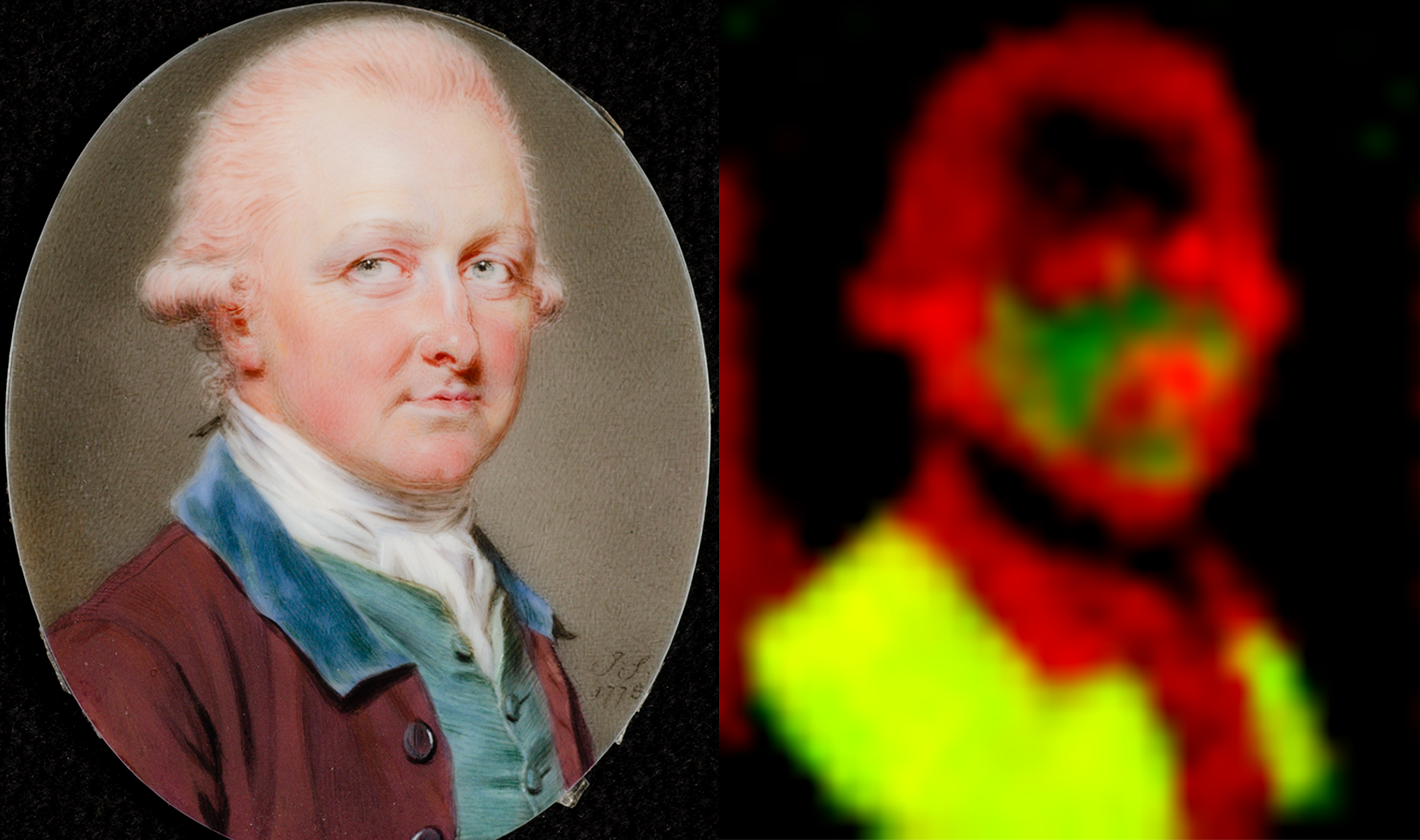
The forehead is notably lighter in complexion, painted with pale yellow, peach, and a translucent wash of magenta, suggesting the man may have worn a hat that protected the top of his head from the sun. Of the two white pigments employed in this portrait, tin oxide was used in the skin and facial features, though not necessarily in the highlights. Blue was used sparingly in the skin tones to deepen shadows and brighten some of the whites, such as the highlight along the bridge of the nose. In Smart’s meticulous style, he included the subtle wrinkles of the forehead with delicate strokes of color and sgraffito: In Italian, meaning “scratched,” an art technique consisting of scratching through layers of paint. (Fig. 2), demonstrating his attention to the most minute of details that make his portraits so realistic compared to the stylized portraiture of other contemporaries such as Richard Cosway (1742–1821). The man’s cleft chin and crow’s feet were painted with darker tones of brown and red. The shadowy area along the man’s jawline was painted with brown hatching and lines of sgraffito to emphasize the shape of his cleft chin. The contour of the man’s nose has a dark outline in short, sketchy brushstrokes of red brown that accentuate the bulbous tip and bump on the bridge.
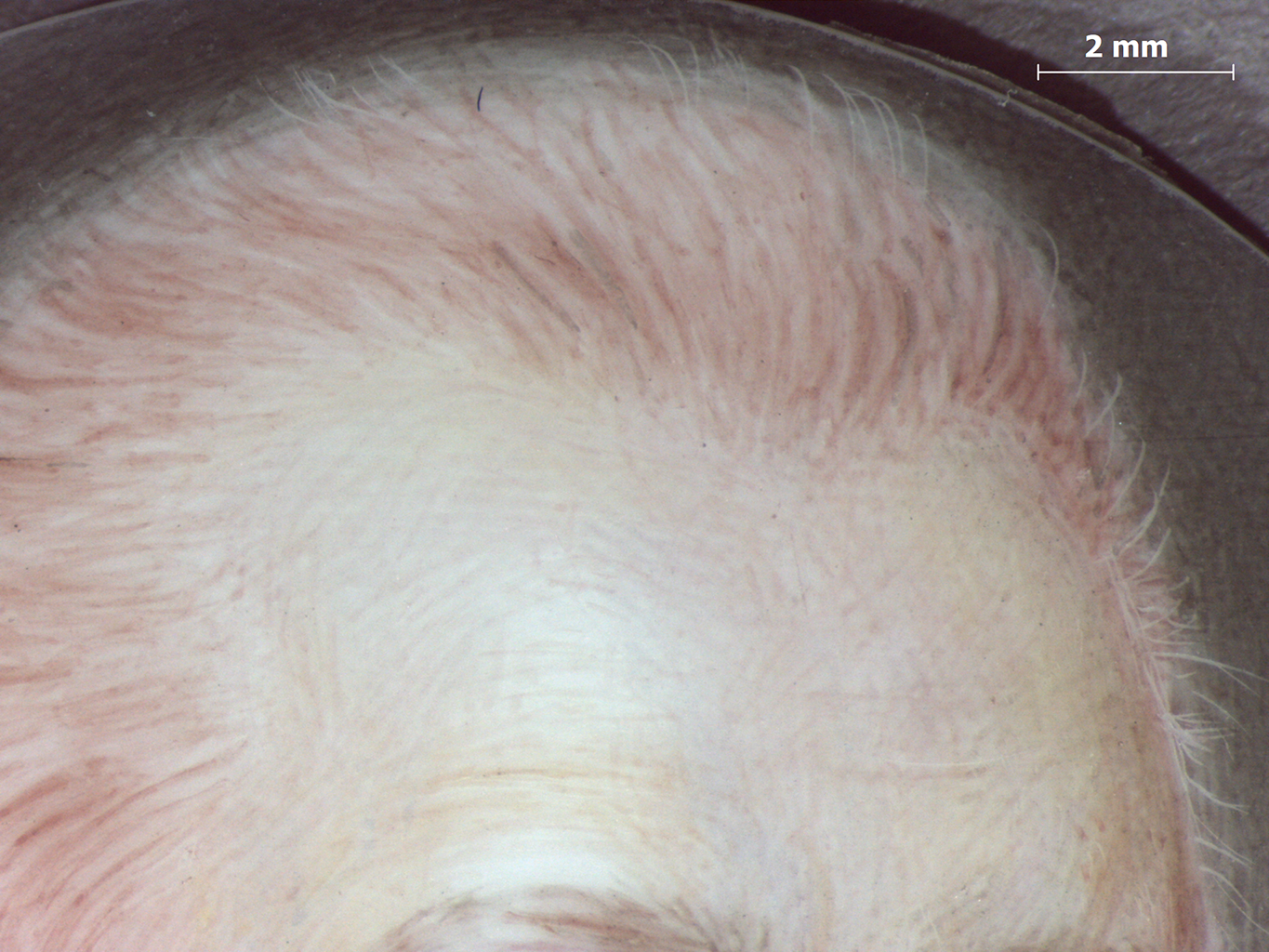
As with many of Smart’s sitters, the lips have a dual color palette of magenta on top and peachy pink on the bottom lip (Fig. 3). The magenta is a similar shade to the lower lip, minimizing the contrast between the two colors, unlike the treatment of mouths in other Smart portraits, such as the Portrait of Charlotte Porcher (F65-41/28). Opaque red brushwork separates the upper and lower lips. Highlights of bare ivory around the lips were created with sgraffito.
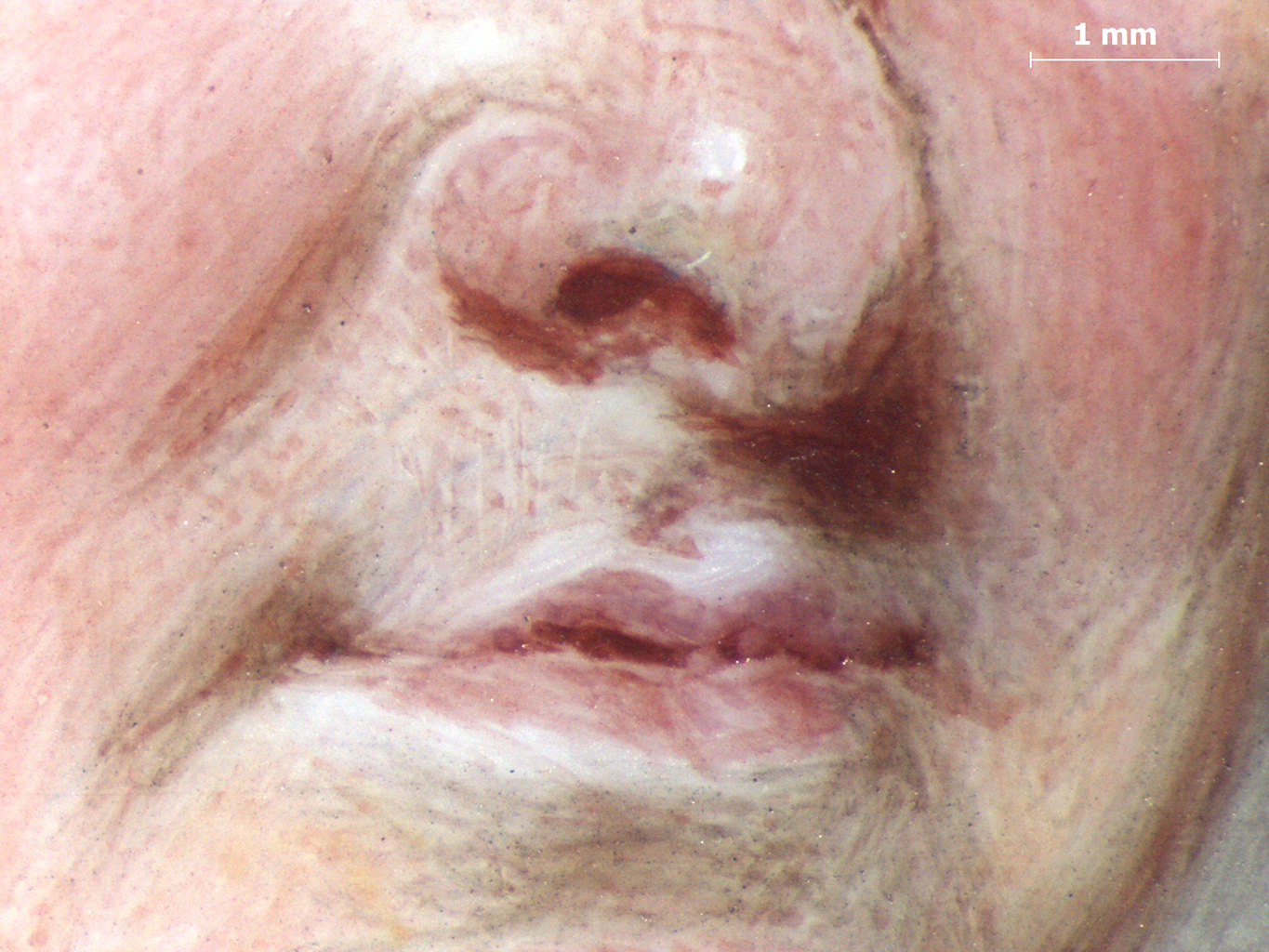
A combination of bare ivory and hues of pale pink, light red, and brown come together in overlapping brushwork and sgraffito in the man’s light pink hair. Individual brushstrokes in pink midtones bring texture to the hair. Brown strokes add further depth to the texture and shading under the curls and neckline. Sgraffito was used to scratch in wisps of hair around the hairline, side curls, and nape of the neck (Fig. 4). Black ribbon peaks out behind the cravat, indicating that the man’s hair is tied back, queue: The long curl of a wig..
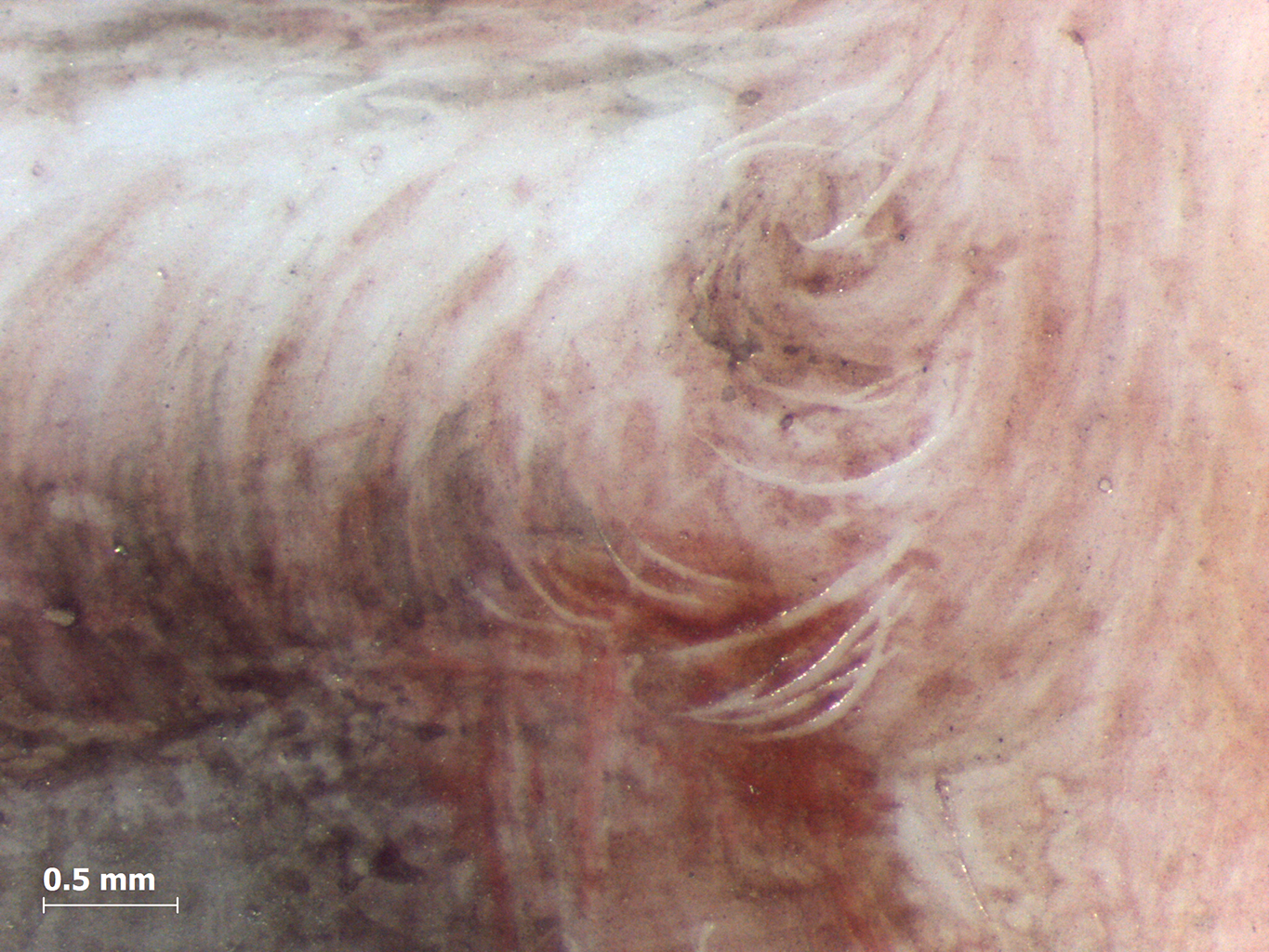
The x-ray fluorescence (XRF) map for iron shows that the pink hair is reliant on iron oxides in the form of red and brown colorants (see Fig. 1). An alternative theory to the purposeful choice of pink-colored, powdered hair is the fading of some light-sensitive pigment that would originally have given the sitter a natural hair color such as brown. Examination of pigment particles from the hair with scanning electron microscopy/energy-dispersive x-ray spectrometry (SEM-EDS): A combined technique that uses a scanning electron microscope and energy-dispersive x-ray spectroscopy to analyze materials. Performed on a microsample of paint, the SEM provides a means of studying particle shapes beyond the magnification limits of the light microscope. The SEM is routinely used in conjunction with an x-ray spectrometer so that elemental identifications can be made selectively on the same minute scale as the electron beam producing the images. SEM methods are particularly valuable in studying unstable pigments, adverse interactions between incompatible pigments, and interactions between pigments and surrounding paint medium, all of which can have profound effects on the appearance of a painting. did not reveal any examples of alumina-based lakes, nor of lakes precipitated on any other compound, which would explain fading of a natural hair color to the light pink color seen today. It remains possible that an organic dye: A natural colorant made from complex organic compounds extracted from plants, animals, insects, lichens, and shellfish. As most natural colorants are soluble, they cannot be mixed directly with a binding medium and therefore must be painted directly onto the surface. Organic dyes can be further processed and precipitated onto an inorganic substrate to produce a lake pigment. See also lake pigment. with yellow, green, or brown color, in soluble form rather than as a lake pigment: An organic pigment manufactured by precipitating a soluble, natural colorant onto a colorless or white, insoluble, inorganic substrate. Historically, natural colorants were extracted from plants and insects. The substrate is traditionally hydrated aluminum oxide, but other substrates such as chalk (calcium carbonate), clay, or gypsum (calcium sulphate) have also been used., was once present along with the surviving iron oxide pigments to produce a more natural hair color.5Lake pigments (suspected as a cause of fading that could result in brown hair turning pink) would be characterized by organic matter and elements such as aluminum that cannot be mapped during MA-XRF. Therefore, particular attention was directed to the detection of alumina particles or alternative lake bases in the SEM. Dye applied in dissolved form (as opposed to being supplied in the form of a dyed colorless solid or “lake”) would not be differentiated from other organic materials such as gouache medium or plant gum in these tests.
The man’s light green eyes are a mixture of transparent blue and green. The irises are outlined in blue and filled with a translucent green so light that the eyes appear icy from a distance. Smart used delicate stippling: Producing a gradation of light and shade by drawing or painting small points, larger dots, or longer strokes. of red shading along the outer edge of the cornea. Under magnification, the dark red shadow above the left eye was corrected by the artist where it initially extended into the nose. Microscopic sgraffito, only visible with high magnification, was employed to scratch out part of the line (Fig. 5).
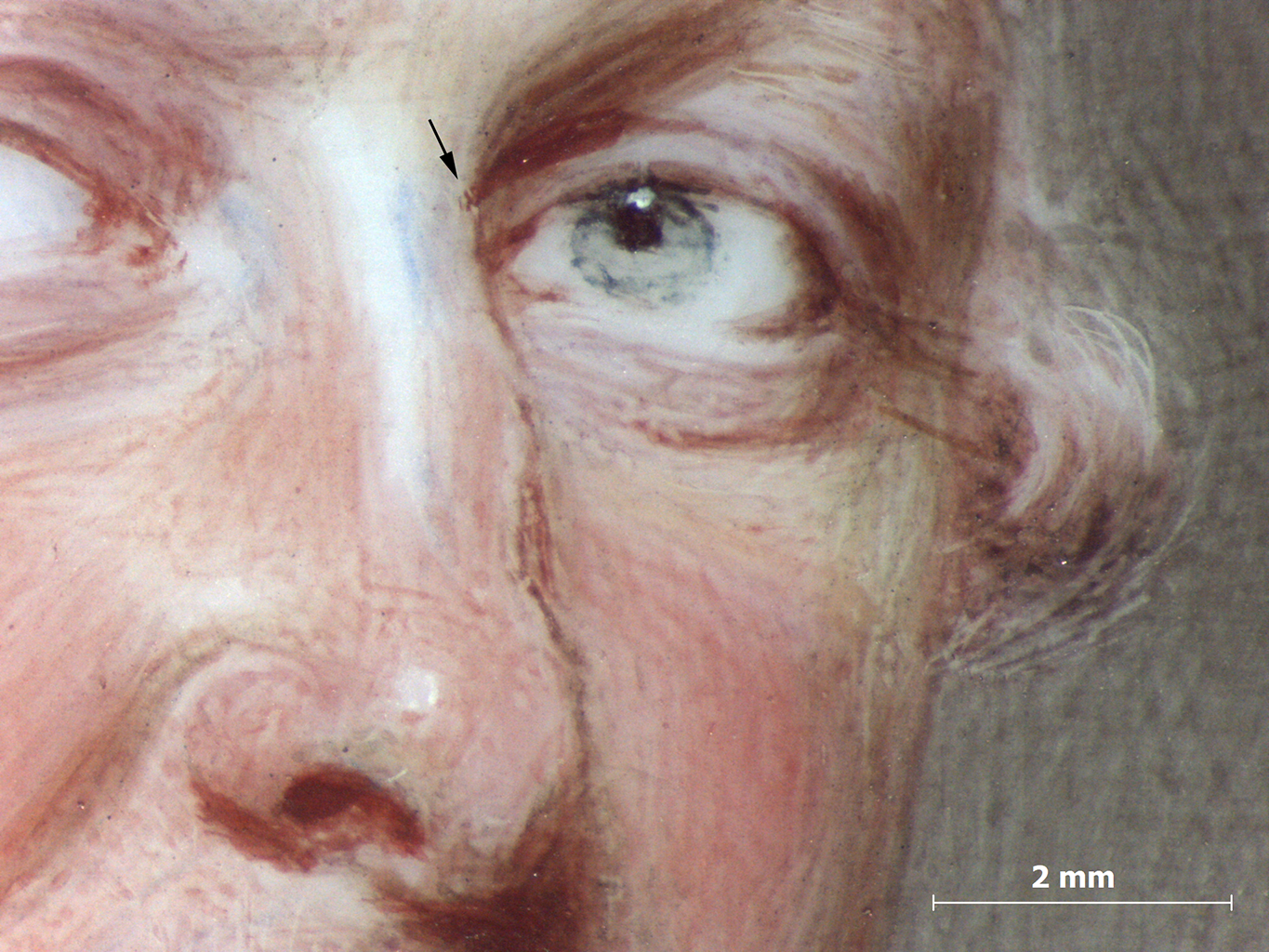
The man is wearing a frock coat of a deep merlot color with a bright blue collar. Two buttons of the same color as the coat are located on the proper right side. The buttons have bright white highlights and dark, gum-saturated cross-hatching for shading. The jacket is a painted with darker hues of merlot and glazing to enhance the saturation and deepen the shadows (Fig. 6). Vermilion plays an important role in this part of the portrait, along with iron oxide red, smalt, and lead white. Although white is not distinguishable in the dark purple color of the coat, the lead map marks the presence of lead white as an opacifier: An additive that increases the opacity or hiding power of the paint. in the gouache: Watercolor with added white pigment to increase the opacity of the colors. paint.6While it is likely that Smart used gouache in many of his miniatures, its presence has only been definitively confirmed in the four works that underwent technical analysis. Smalt (marked by the correlated distributions of cobalt, silica, and potassium) was used in the merlot coat where it establishes the color by blending with vermilion and an iron red.
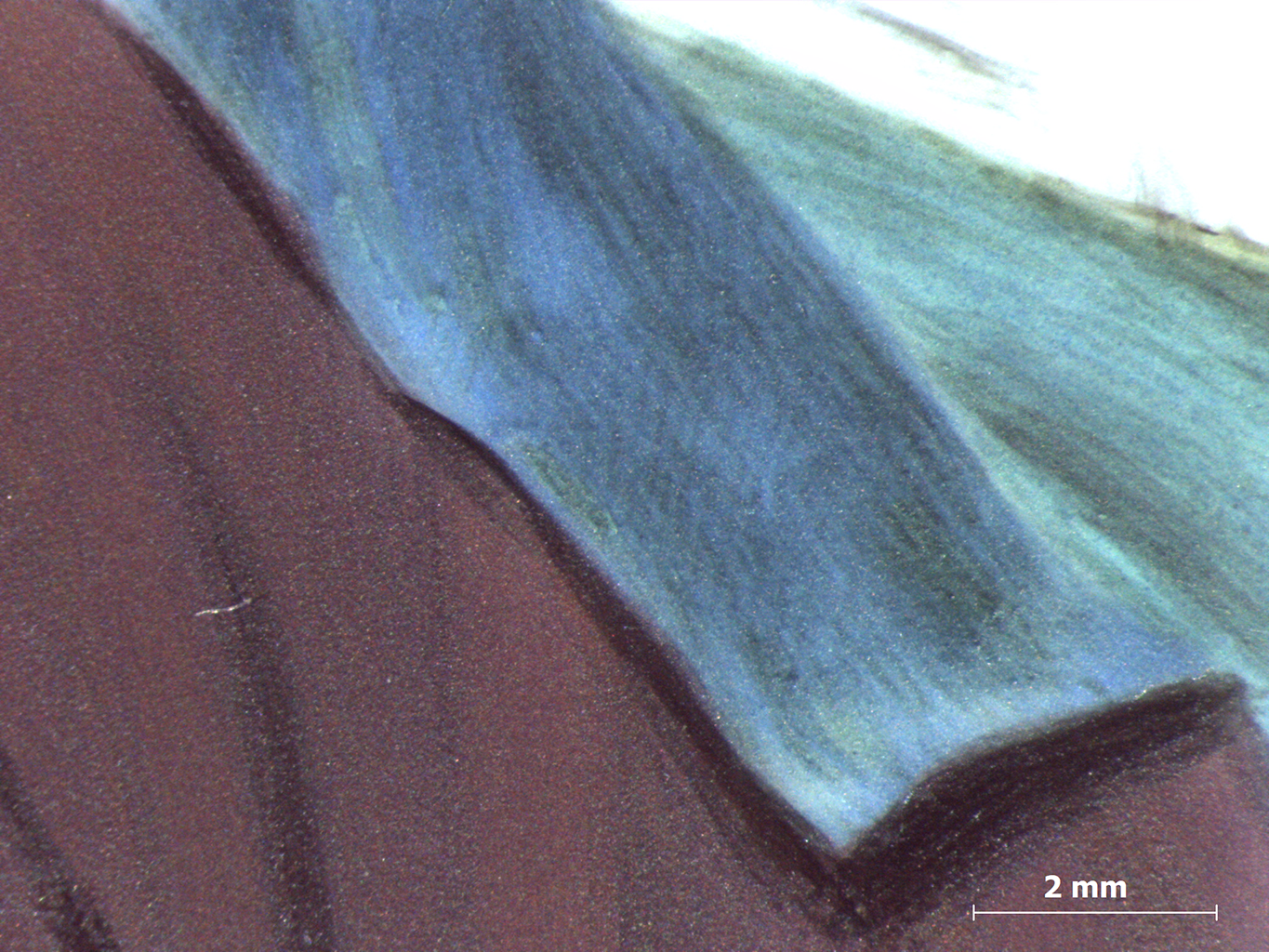
Smart’s technique for creating the coat was complex. Gouache was “floated on” the ivory with a brush heavily loaded with paint that left an even layer of opaque, matte color. Floating describes a technique widely used for painting men’s coats that relied on the interplay of the matte gouache with the transparent paint used in the head and background.7John Murdoch et al., The English Miniature (New Haven: Yale University Press, 1981), 20. The hatched shadows were created by overpainting with a plant gum, either in pure form or in mixture with small amounts of pigment, where saturation by the gum solution would reduce the light scatter from the paint texture, darkening it to create deeper shadows. In the case of this portrait, the infrared (IR) photography: A form of infrared imaging that employs the part of the spectrum just beyond the red color to which the human eye is sensitive. This wavelength region, typically between 700–1,000 nanometers, is accessible to commonly available digital cameras if they are modified by removal of an IR-blocking filter that is required to render images as the eye sees them. The camera is made selective for the infrared by then blocking the visible light. The resulting image is called a reflected infrared digital photograph. Its value as a painting examination tool derives from the tendency for paint to be more transparent at these longer wavelengths, thereby non-invasively revealing pentimenti, inscriptions, underdrawing lines, and early stages in the execution of a work. The technique has been used extensively for more than a half-century and was formerly accomplished with infrared film. reveals that carbon black is a component in the paint mixture of the shadows (Fig. 7). The dark, infrared-absorptive areas in the coat align with the shadows. While extremely subtle even under magnification, this makes an important contribution to the realism of the portrait.
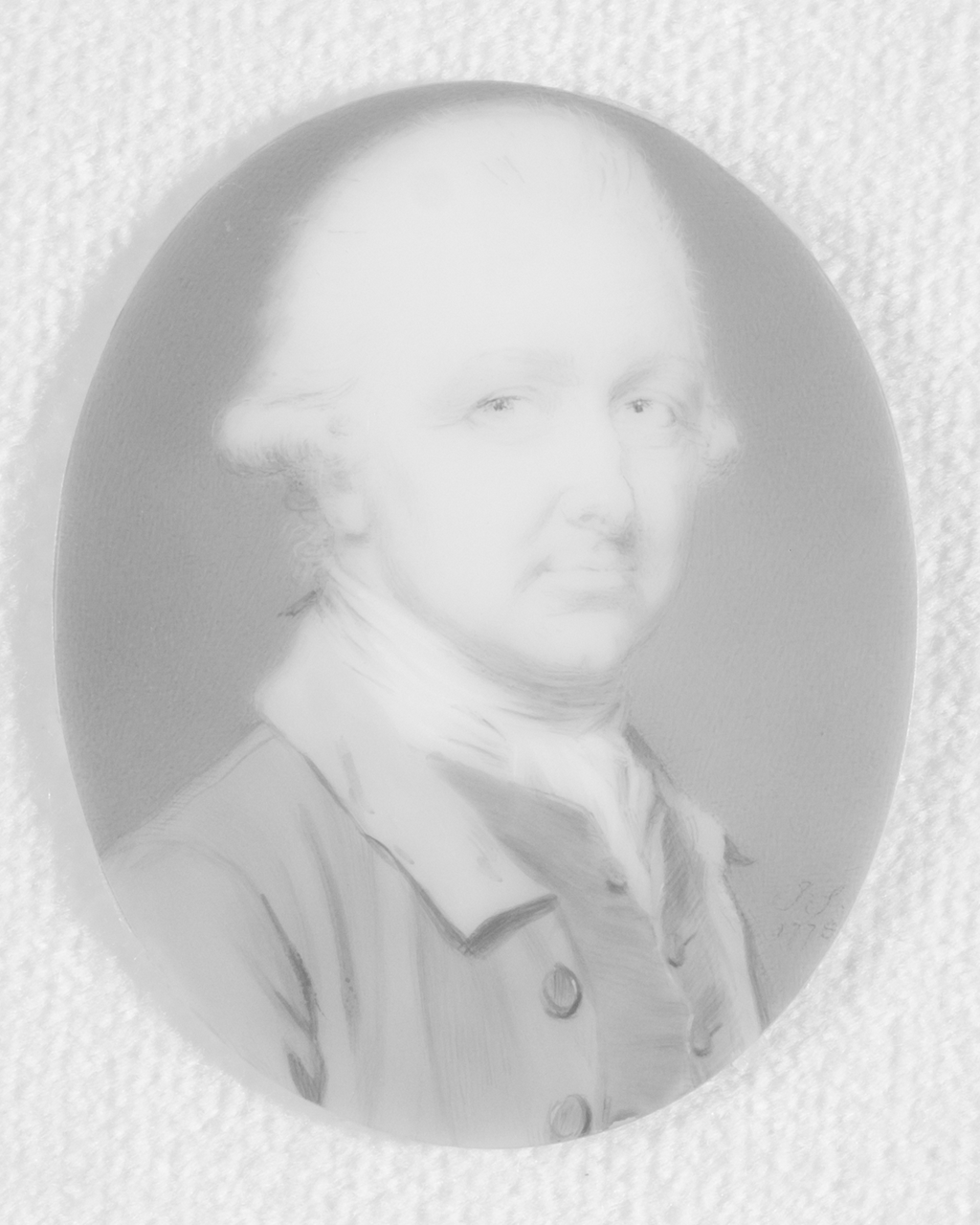
Even the coloring of the lapels and waistcoat are not produced with a single color. The blues in this portrait rely on the simultaneous use of two blue pigments: a copper blue and ultramarine (shown in the sulfur map). The opaque color was built up by overlaying brushstrokes of highlights and shading in blue, green, and black to produce the texture and undulations in the fabric (see Fig. 6). While the overall color of the waistcoat is teal, dark gray hatching produces the shading and outlines of the three buttons and buttonholes, with the rippling fabric around the buttons giving a true sense of the fitted form. Copper blue plays a role in the blue highlight of the collar and the waistcoat. Yellow-green brushstrokes and a dilute wash of ultramarine complete the composition. A highlight on the exposed interior of the waistcoat is a mint green tone from a mixture of teal and white. White was also employed to create subtle highlights in the details.
The roles of silicon, sulfur, and potassium are complex and may involve pigments other than these blues. While silicon and sulfur occur together in ultramarine, potassium is not part of the composition of ultramarine, apart from small amounts in accessory minerals. Conversely, sulfur is not a component of smalt. Yet these three elements share the same distribution, while cobalt does not. Therefore, something more complicated than a blend or overpainting of smalt and ultramarine is going on. The image in which silicon (ultramarine), potassium, and cobalt (smalt) are depicted with red, green, and blue, respectively, illustrates this (Fig. 8). The remaining uncertainty would be resolved by microanalytical tests of the paint, which were not done at this location in the miniature.

Smart exploited the attributes of the translucent ivory surface as the base color in his rendering of the man’s white stock. The XRF elemental map for phosphorous, a component of ivory (along with calcium and strontium), shows the strongest response in the stock where bare ivory is exposed. Smart also incorporated opaque white strokes for highlights, gray-brown for shadows and drapery, and light blue washes for shadowy midtones. The white stock employs ultramarine for shading and calcium carbonate for white highlights. This use of calcium carbonate in white highlights was only apparent due to the SEM analysis of samples, since calcium is universally present in the ivory support and could not be differentiated in XRF mapping. The IR image also indicates that the darkest shading includes a carbon-black pigment in the paint mixture.
Short, dense hatch marks create depth in the gray-brown background. Directional brushstrokes around the hair were applied over the pink, indicating that the background was laid in after the portrait. The relative absence of iron in the background, except in the darkest area along the outer edge of the right side, contrasts with the artist’s overall use of iron pigment in the other male portrait (F65-41/11) examined for the catalogue. The presence of sulfur indicated by the XRF map suggests that ultramarine is part of the background composition. Lead white was used sparingly in the background, and localized areas of tin oxide seem to play a role in the lighter areas closest to the figure. The gradation varies from light highlights surrounding the sitter to a darker tone on the left side, giving the sense that the light source is positioned in front of the sitter.
The results of analyses of this corpus of John Smart miniatures extend beyond the peculiarity of the sitters with light pink and lilac-tinted hair, revealing previously unknown information about Smart’s palette. Comparisons of the four portraits spanning a twenty-five-year period of Smart’s career have brought to light ways in which he innovated beyond methods described in contemporaneous painting treatises. Additionally, they illuminate pronounced differences in his approach to representation of male and female sitters. While the analyses do not reveal the use of lake pigments in the hair and fail to account for a color change, the possibility remains that now-faded organic dyes, not detectable by the methods available to the authors, could account for a color change. XRF elemental mapping used in conjunction with SEM-based elemental analysis has provided pigment identifications for part of the palette. Complementary information from additional analytical steps holds the potential for a comprehensive understanding of John Smart’s palette to be derived from the extensive holdings of the Nelson-Atkins Museum of Art.
Notes
-
See Aimee Marcereau DeGalan, “Pretty in Pink: John Smart’s Penchant (or Not) for Pink Hair,” in this catalogue.
-
See John Smart, Portrait of a Man, 1773, F65-41/11; Portrait of Charlotte Porcher, 1787, F65-41/28; and Portrait of Mrs. Ronalds, 1798, F65-41/39.
-
The scientific study of the four John Smart portraits via x-ray spectrometry and SEM analyses was carried out by John Twilley, Mellon Science Advisor, with support of an endowment from the Andrew W. Mellon Foundation for conservation science at The Nelson-Atkins Museum of Art.
-
Technical imaging employs technology to observe an object in wavelength ranges that extend beyond the capabilities of the human eye, from the ultraviolet (UV) to the near infrared (NIR). Images were captured using an UV-VIS-IR-modified Nikon D7000 DSLR camera with a 60mm lens and a set of UV-VIS-IR bandpass filters. The imaging included ultraviolet illumintation (UVL), reflected infrared (IR), reflected ultraviolet (RUV), visible-induced visible luminescence (VIVL), false-color UV (FCUV), and false-color IR (FCIR). These imaging techniques can identify restoration materials such as inpainting, varnish coatings, as well as materials not readily visible to the naked eye. Imaging is a means to examine the surface of an artwork and discover materials that require identification through scientific analysis.
-
Lake pigments (suspected as a cause of fading that could result in brown hair turning pink) would be characterized by organic matter and elements such as aluminum that cannot be mapped during MA-XRF. Therefore, particular attention was directed to the detection of alumina particles or alternative lake bases in the SEM. Dye applied in dissolved form (as opposed to being supplied in the form of a dyed colorless solid or “lake”) would not be differentiated from other organic materials such as gouache medium or plant gum in these tests.
-
While it is likely that Smart used gouache in many of his miniatures, its presence has only been definitively confirmed in the four works that underwent technical analysis.
-
John Murdoch et al., The English Miniature (New Haven: Yale University Press, 1981), 20.
Provenance
Unknown woman, by July 13, 1950 [1];
Purchased from her sale, Portrait Miniatures, Objects of Vertu, Fine Watches, Gold Boxes, Etc., Sotheby’s, London, July 13, 1950, lot 6, as A Young Man, by Leggatt Brothers, London, probably on behalf of Mr. John W. (1905–2000) and Mrs. Martha Jane (1906–2011) Starr, Kansas City, MO, 1950–1965 [2];
Their gift through the Starr Foundation to the Nelson-Atkins Museum of Art, Kansas City, MO, 1965.
Notes
[1] According to the sales catalogue, lots 1–6 were the “Property of a Lady.”
[2] According to the lot description, “A Miniature of a Young Man, by John Smart, signed and dated 1778, head and shoulders three-quarters sinister, gaze directed at spectator, fresh complexion, red-tinted hair en queue, in lace-bordered green waistcoat and brown coat, 2in.” According to Art Prices Current 27 (1949–50), Leggatt bought lot 6 for £68. Archival research has shown that Leggatt Brothers served as purchasing agents for the Starrs. See correspondence between Betty Hogg and Martha Jane Starr, May 15 and June 3, 1950, Nelson-Atkins curatorial files. The Starrs also acquired lot 5, Gore Townsend, see https://www.nelson-atkins.org/starrsupp/Other-Locations/4795/.
Exhibitions
John Smart—Miniaturist: 1741/2–1811, The Nelson-Atkins Museum of Art, Kansas City, MO, December 9, 1965–January 2, 1966, no cat., as Gentleman.
The Starr Foundation Collection of Miniatures, The Royal Ontario Museum, Toronto, December 8, 1972–January 14, 1973, no cat., no. 104, as Unknown Man.
John Smart: Virtuoso in Miniature, The Nelson-Atkins Museum of Art, Kansas City, MO, December 21, 2024–January 4, 2026, no cat., as Portrait of a Man.
References
Catalogue of Portrait Miniatures, Objects of Vertu, Fine Watches, Gold Boxes, Etc. (London: Sotheby’s, July 13, 1950), 4.
Ross E. Taggart, The Starr Collection of Miniatures in the William Rockhill Nelson Gallery (Kansas City, MO: Nelson Gallery-Atkins Museum, 1971), no. 104, p. 39, (repro.), as Unknown Man.
No known related works at this time. If you have additional information on this object, please tell us more.